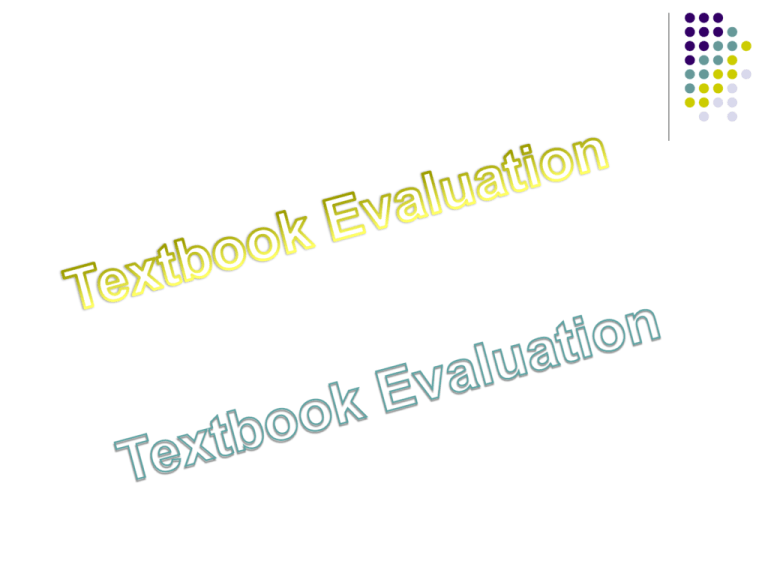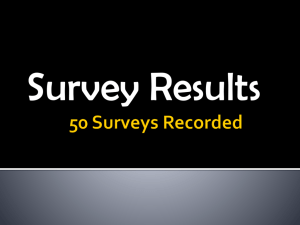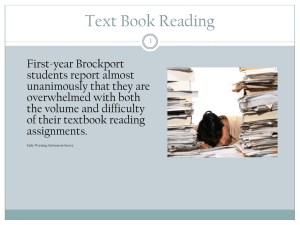Disadvantages of Textbooks
advertisement

Textbook Evaluation The Role of Textbooks in the EFL/ESL Classroom: A course book could be defined as: 1/ “…a textbook which is meant to provide the core materials for a course. It aims to provide as much as possible in one book and is designed so that it could serve as the only book learners necessarily use during a course” 2/ "The textbook is an almost universal element of [English language] teaching. Millions of copies are sold every year, and numerous aid projects have been set up to produce them in [various] countries…No teaching-learning situation, it seems, is complete until it has its relevant textbook. " Advantages of textbooks: Textbooks do not only represent the visible heart of any ELT program, but also offer considerable advantages - for both the student and the teacher - when they are being used in the ESL/EFL classroom. They have the following advantages: Advantages of textbooks: 1/ One of the primary advantages of using textbooks is that they are psychologically essential for students since their progress and achievement can be measured concretely when we use them. Advantages of textbooks: 2/ Students often keep in mind expectations about using a textbook in their particular language classroom and program and believe that published materials have more credibility than teacher-generated or "inhouse" materials. Advantages of textbooks: 3/ Textbooks are generally sensitive to students' needs, even if they are not designed specifically for them, they are efficient in terms of time and money, and they can and should allow for adaptation and improvisation. improvise v. (improvises, improvising, improvised) 1. invent and perform (music, drama, or poetry) on the spur of the moment. 2. make from whatever is available. Advantages of textbooks: 4/ Textbooks are economical- relatively inexpensive and involve low lesson preparation time, whereas teacher-generated materials can be time consuming and quality defective. Advantages of textbooks: 5/ They are potential for serving several additional roles in the ELT curriculum: (a) They are an effective resource for selfdirected learning; (b) an effective resource for presentation material; (c) a source of ideas and activities; Advantages of textbooks: (d) a reference source for students; (e) a syllabus where they reflect predetermined learning objectives, (f) and support for less experienced teachers who have yet to gain in confidence. Disadvantages of Textbooks There are many researchers and practitioners who are not in favor of textbooks, and propose the following disadvantages: Disadvantages of Textbooks 1/ Textbooks are too inflexible and generally reflect the pedagogic, psychological, and linguistic preferences and biases of their authors. Textbooks essentially determine and control the methods, processes and procedures of language teaching and learning. Disadvantages of Textbooks 2/ More recent authors have criticized textbooks for their inherent social and cultural biases. Researchers have demonstrated that many EFL/ESL textbooks still contain rampant examples of gender bias, sexism, and stereotyping. Disadvantages of Textbooks 3/ Other theorists have focused on the use of the target language culture as a vehicle for teaching the language in textbooks and suggest that it is not really possible to teach a language without embedding it in its cultural base. Disadvantages of Textbooks 4/ They are actually too contrived and artificial in their presentation of the target language. They argue that it is crucial to introduce learners to the fundamental characteristics of authentic real life examples of both spoken and written discourse. Disadvantages of Textbooks 5/ A final reason for disappointment with many ELT textbooks is the fact that they are often regarded as the "…tainted end-product of an author's or a publisher's desire for quick profit"). taint n. a trace of an undesirable quality or substance. v. 1. make impure. 2. affect with an undesirable quality: Disadvantages of Textbooks Too many textbooks are often marketed with grand artificial claims by their authors and publishers yet these same books tend to contain serious theoretical problems, design flaws, and practical shortcomings. flaw n. 1. a mark or fault that spoils something. 2. a weakness or mistake. v. spoil or weaken. Reasons for Textbook Evaluation 1/ A thorough evaluation would enable the administrative and teaching staff of a specific institution or organization to discriminate between all of the available textbooks on the market . Reasons for Textbook Evaluation 2/ Textbook evaluation would provide a sense of familiarity with a book's content thus assisting educators in identifying the particular strengths and weaknesses in textbooks already in use. Reasons for Textbook Evaluation This would go a long way in ultimately assisting teachers with making optimum use of a book's strong points and recognizing the shortcomings of certain exercises, tasks, and entire texts. optimum adj. most likely to lead to a favourable outcome: Reasons for Textbook Evaluation 3/ One additional reason for textbook evaluation is the fact that it can be very useful in teacher development and professional growth. Reasons for Textbook Evaluation Textbook evaluation helps teachers move beyond impressionistic assessments and it helps them to acquire useful, accurate, systematic, and contextual insights into the overall nature of textbook material Textbook Evaluation Criteria: Textbooks are evaluated according to the following criteria: A/ Practical Considerations B/ Layout and Design C/ Activities D/ Skills E/ Language Type F/ Subject and Content G/ Miscellaneous Textbook Evaluation Checklist: A/ Practical Considerations: 1. Is the price of the textbook reasonable? 2. Is the textbook easily accessible? 3. Is the textbook a recent publication? 4. Do a teacher's guide, workbook, and audiotapes accompany the textbook? 5. Are the author's views on language and methodology comparable to the user’s ? B/ Layout and Design: 6. Does the textbook include a detailed overview of the functions, structures and vocabulary that will be taught in each unit? 7. Is the layout and design appropriate and clear? 8. Is the textbook organized effectively? 9.Is an adequate vocabulary list or glossary included? 10. Are adequate review sections and exercises included? B/ Layout and Design: 11. Is an adequate set of evaluation quizzes or testing suggestions included? 12. Does the teacher's manual contain guidance about how the textbook can be used to the utmost advantage? 13. Are the materials objectives apparent to both the teacher and student? utmost adj. most extreme; greatest. C/ Activities: 14. Does the textbook provide a balance of activities (e.g. is there an even distribution of free vs. controlled exercises and tasks that focus on both fluency and accuracy)? 15. Do the activities encourage sufficient communicative and meaningful practice? 16. Do the activities incorporate individual, pair and group work? C/ Activities: 17. Are the grammar points and vocabulary items introduced in motivating and realistic contexts? 18. Do the activities promote creative, original and independent responses? 19. Are the tasks conducive to the internalization of newly introduced language? 20. Can the textbook's activities be modified or supplemented easily? internalize make (a belief or attitude) part of one's behaviour or thinking. D/ Skills: 21. Do the materials include and focus on the skills that I/my students need to practice? 22. Do the materials provide an appropriate balance of the four language skills? 23. Does the textbook pay attention to subskills - i.e. listening for gist, note-taking, skimming for information, etc? D/ Skills: 24. Does the textbook highlight and practice natural pronunciation (i.e.- stress and intonation). 25. Is the practice of individual skills integrated into the practice of other skills? E/ Language Type: 26. Is the language used in the textbook authentic - i.e. like real-life English? 27. Is the language used at the right level for my (students') current English ability? 28. Is the progression of grammar points and vocabulary items appropriate? E/ Language Type: 29. Are the grammar points presented with brief and easy examples and explanations? 30. Do the language functions exemplify English that I/my students will be likely to use? F/ Subject and Content: 32. Is the subject and content of the textbook relevant to my students' needs as English language learners? 33. Is the subject and content of the textbook generally realistic? 34. Is the subject and content of the textbook interesting, challenging and motivating? 35. Is there sufficient variety in the subject and content of the textbook? 36. Are the materials not culturally biased and they do not portray any negative stereotypes? stereotype n. an over-simplified idea of the typical characteristics of a person or thing. v. (stereotypes, stereotyping, stereotyped) view as a stereotype. G/ Miscellaneous: 37. Is the textbook appropriate for the language-learning aims of my institution? 39. Does the textbook raise my (students') interest in further English language study?




